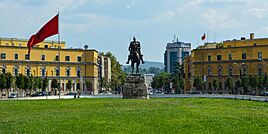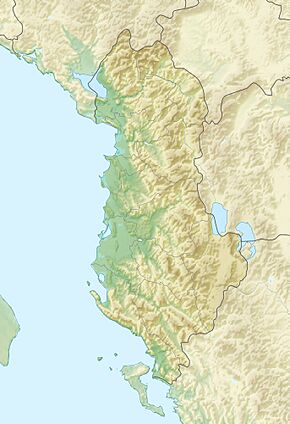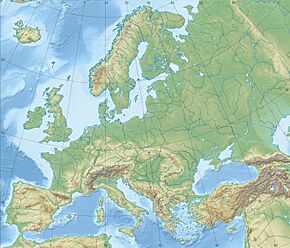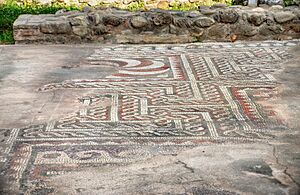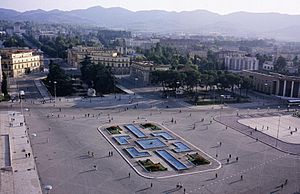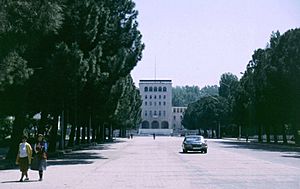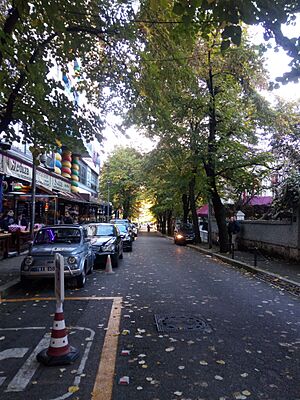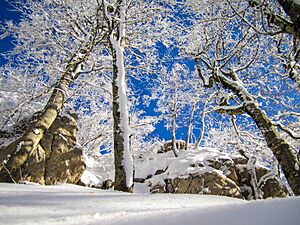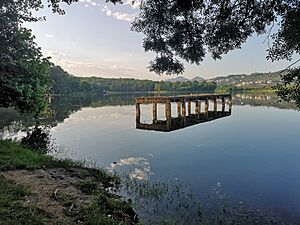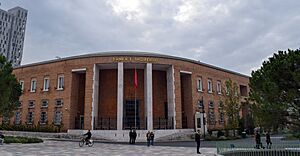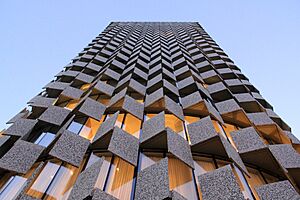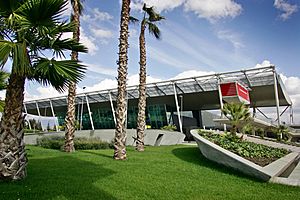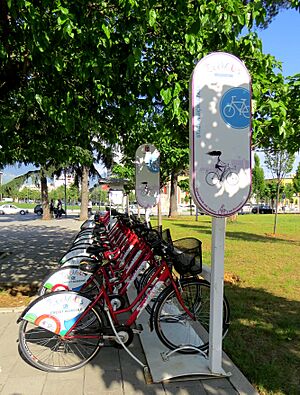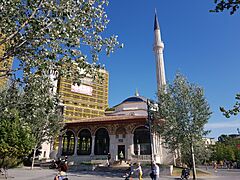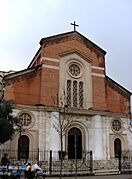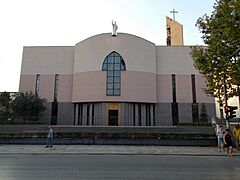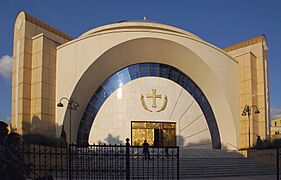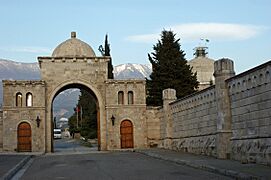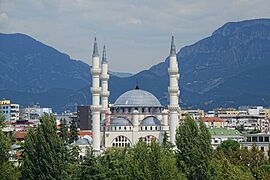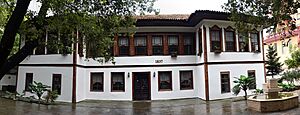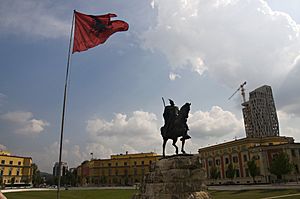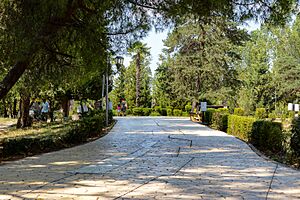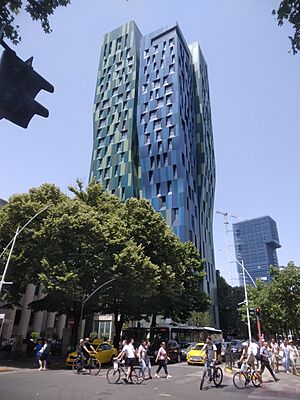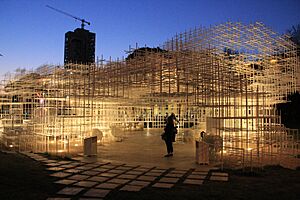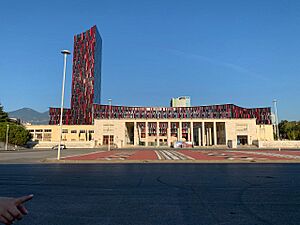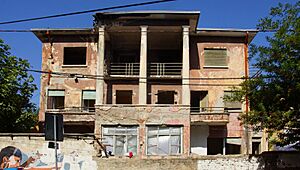Tirana facts for kids
Quick facts for kids
Tirana
Tirona
|
|||
|---|---|---|---|
|
Skanderbeg Square
Toptani Centre
Kapllan Pasha Tomb
Resurrection Orthodox Cathedral
Namazgah Mosque
Petrelë Castle
Clock Tower
|
|||
|
|||
| Country | Albania | ||
| Region | Central Albania | ||
| County | Tirana | ||
| Municipality | Tirana | ||
| Settled | 1614 | ||
| Government | |||
| • Type | Mayor–council | ||
| Area | |||
| • Total | 1,110 km2 (430 sq mi) | ||
| • Unit | 41.8 km2 (16.1 sq mi) | ||
| Elevation | 110 m (360 ft) | ||
| Population | |||
| • Municipality | 598,176 | ||
| • Municipality density | 502/km2 (1,300/sq mi) | ||
| • Unit | 418,495 | ||
| Demonym(s) | Albanian: Tiranas (m), Tiranase (f) Tirana dialect: Tirons (m), Tironse (f) |
||
| GDP | |||
| • Total | €15.1 billion (2023) | ||
| • Per capita | €8.642 (2024) | ||
| Time zone | UTC+1 (CET) | ||
| • Summer (DST) | UTC+2 (CEST) | ||
| Postal code(s) |
1000-1054
|
||
| Area code(s) | +355 (0) 4 | ||
| Airport | Nënë Tereza Airport | ||
| Motorways | |||
| Highways | |||
| Vehicle registration | TR | ||
Tirana (![]() i/tɪˈrɑːnə/ tih-RAH-nə, Albanian pronunciation: [tiˈɾana]; Gheg Albanian: Tirona) is the capital and largest city of Albania. It is located in the center of the country, surrounded by mountains and hills. To the east, you can see Dajti mountain, and to the northwest, a valley looks out towards the distant Adriatic Sea. Tirana is known for being one of the wettest and sunniest cities in Europe, getting about 2,544 hours of sunshine each year.
i/tɪˈrɑːnə/ tih-RAH-nə, Albanian pronunciation: [tiˈɾana]; Gheg Albanian: Tirona) is the capital and largest city of Albania. It is located in the center of the country, surrounded by mountains and hills. To the east, you can see Dajti mountain, and to the northwest, a valley looks out towards the distant Adriatic Sea. Tirana is known for being one of the wettest and sunniest cities in Europe, getting about 2,544 hours of sunshine each year.
People have lived in the area where Tirana is today since the Iron Age. It was likely the main part of the ancient Illyrian kingdom of the Taulantii. Later, it became part of the Roman Empire, and you can still see this history in the Mosaics of Tirana. After the Western Roman Empire fell, Albania was controlled by the Byzantine Empire. Petrelë Castle, built by Emperor Justinian I, shows this period. Tirana was officially founded in 1614 by an Ottoman general named Sylejman Pasha Bargjini. It became Albania's capital in 1920, after the country gained independence in 1912.
Tirana is a very important city for Albania's economy, money, politics, and trade. This is because it's located right in the middle of the country. It also has modern ways to travel, like by air, sea, train, and road. As the main city for the Government of Albania, it's where the President, Prime Minister of Albania, and Parliament of Albania work. In 2022, Tirana was named the European Youth Capital, which is a big deal for young people!
Contents
Exploring Tirana's Past
How Tirana Grew Over Time
People have lived in the Tirana area since very old times, even before history was written down. The first people here were the Illyrians. They likely formed a kingdom in this area. When the Romans arrived, they made the area part of their empire. The oldest Roman discovery here is a house from the 3rd century. It had a mosaic floor and was later turned into a church. A castle, possibly called Tirkan, was built by a Byzantine Emperor named Justinian I between the 4th and 6th centuries.
Tirana is mentioned in old documents from the 1300s and 1400s. Records from the Ottoman Empire in the 1430s show that Tirana had about 60 villages with many houses and people. In 1510, a scholar named Marin Barleti called it a small village. He even talked about "Little Tirana" and "Great Tirana."
In 1614, a local leader named Sulejman Bargjini built the Old Mosque, a market, and a Turkish bath. This helped the settlement grow. Later, the Et'hem Bey Mosque was built, finished in 1821. It used the best builders in the country.
Around 1800, new people, called ortodoksit, came to Tirana. They were from nearby villages and settled around what is now Tirana Park on the Artificial Lake. In 1889, the Albanian language began to be taught in Tirana's schools.
Tirana in Modern Times
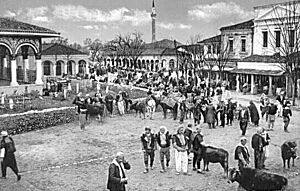
On November 28, 1912, Albania declared its independence. The next few years were difficult. During the Balkan Wars, the Serbian army briefly took over Tirana. On February 8, 1920, Tirana was chosen as the temporary capital of Albania. It became the permanent capital on December 31, 1925.
In the 1920s, architects from Austria and Italy helped plan the modern city center. They designed the government buildings you see today. In 1928, Zog of Albania was crowned King Zog I in Tirana. Many people moved to Tirana during his rule, making the city's population grow.
In 1939, Italy took over Tirana during World War II. Later, in 1941, the Communist Party of Albania was founded here. Tirana became the center for Albanian communists who fought against the Italian and German forces. On November 17, 1944, the city was freed after a big battle. The communists then took control.
From 1944 to 1991, during the communist era, many apartment buildings and factories were built. Skanderbeg Square was also redesigned, and some old buildings were torn down. For example, the Old Bazaar and the Orthodox Cathedral were removed to build the Palace of Culture. Private cars were not allowed, so people mostly used bicycles, trucks, and buses.
After the communist leader Enver Hoxha died, a pyramid-shaped museum was built in his memory. In the early 1990s, students from the University of Tirana held big protests in the city. They wanted more political freedom. These protests led to the end of communism in Albania.
After communism ended, important people like U.S. Secretary of State James Baker and Pope John Paul II visited Tirana. In 1997, the city saw some unrest, and in 1998, there was a failed attempt to overthrow the government. In 1999, during the Kosovo War, Tirana Airport became a NATO airbase.
Tirana Today
From 2000 to 2011, the former mayor of Tirana, Edi Rama, worked to remove illegally built buildings and widen roads. He also had many buildings painted in bright colors. In June 2007, George W. Bush became the first U.S. President to visit Albania. In 2014, Pope Francis also visited Tirana.
After the 2015 elections, Erion Veliaj became the new mayor. Tirana has been changing a lot since then, with new buildings and projects. In 2018-2019, students protested in Tirana about education issues. In September 2019, a strong earthquake hit the region, causing some damage in Tirana. Later that year, Tirana was chosen as the European Youth Capital for 2022.
Recently, in 2024, there were reports about plans to create a special area within Tirana for the Bektashi Order, a religious group.
Tirana's Location and Environment
Tirana is located in the center of Albania, on the Tirana plain. To the east is Dajti mountain, and to the south are the hills of Kërrabe, Sauk, and Vaqarr. The city is about 110 meters (360 feet) above sea level. The highest point nearby is Maja Mincekut, at 1828 meters (5,997 feet).
The city is surrounded by two important nature areas: the Dajti National Park and Mali me Gropa-Bizë-Martanesh Protected Landscape. In winter, the mountains often have snow, which is a popular spot for people from Tirana. The forests here have pine, oak, and beech trees. There are also canyons, waterfalls, caves, and lakes. Dajti mountain is sometimes called the "Natural Balcony of Tirana" because of its beautiful views.
The Tiranë river and the Lanë river flow through the city. Tirana also has several artificial lakes, like the ones in Tirana, Farka, Tufina, and Kashar. The current city area was formed in 2015 by combining several smaller towns and villages.
Tirana's Weather
Tirana has a humid subtropical climate. This means it has hot, humid summers and mild winters. The city gets about 1266 mm (50 inches) of rain each year. Most of the rain falls in the winter months, from November to March. Tirana is one of the wettest cities in Europe.
Temperatures change throughout the year. In January, the average temperature is about 6.7°C (44°F). In July, it's around 24°C (75°F). Summers are very warm, often reaching over 20°C (68°F) from May to September. Tirana gets a lot of sunshine, about 2500 hours per year.
City Planning and Environment
In September 2015, Tirana started its first car-free day to help reduce air pollution. This idea worked well, so the city now has a car-free day every month.
Tirana faces some challenges because of its growing population. These include managing waste, air pollution, and noise pollution. The number of cars has increased, and many are older diesel cars. To help with pollution, the government banned importing used cars made before 2005.
Despite these issues, the Grand Park at the Artificial Lake helps absorb carbon dioxide. More than 2,000 trees have also been planted along sidewalks. The city is also building four new large parks to increase green spaces. The government has also created a "Tirana Greenbelt" where new construction is not allowed.
Tirana's Economy
Tirana is the most important economic center in Albania. It is the fastest-growing region for business and industry. Most jobs in Tirana are in the service sector (like banking and tourism), which employs over 68% of workers. Manufacturing and construction employ 26%, and agriculture only 5%.
The city started to grow as a trade center in the 1500s under the Ottoman Empire. Craftsmen made things like silk, cotton, leather, and metal goods. In the 20th century, Tirana became the most industrial area in Albania.
The service industry has grown a lot since communism ended. Tirana is the financial heart of Albania. Important financial groups like the Bank of Albania and the Albanian Stock Exchange are here. Many banks also have their main offices in Tirana.
The telecommunications industry is also growing quickly. Companies like Vodafone and Telekom Albania are major providers. Tourism has also become a very important part of Tirana's economy. The city has even been called 'The Place Beyond Belief' by local leaders. More and more international visitors are coming to Tirana.
The city has many large hotels, including the Tirana International Hotel and Maritim Plaza Tirana. These hotels are located in the heart of the city, close to Skanderbeg Square.
Getting Around Tirana
Air Travel
Tirana is served by Nënë Tereza International Airport. This is the main airport for all of Albania. It is named after the famous Albanian nun, Mother Teresa. The airport connects Tirana to many cities in Europe, Africa, and Asia. In 2019, over 3.3 million passengers used the airport. It is also the main base for Albania's national airline, Air Albania.
Roads
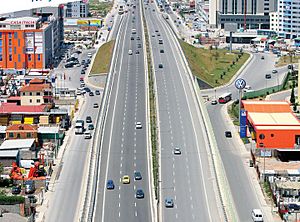
Tirana's central location makes it a key point for national road travel. Roads connect the city to all parts of Albania and neighboring countries. For example, the Rruga Shtetërore 1 (SH1) goes north to Shkodër and Montenegro. The Rruga Shtetërore 2 (SH2) goes west to Durrës on the Adriatic Sea. The Rruga Shtetërore 3 (SH3) is becoming the Autostrada 3 (A3), linking Tirana to Elbasan, Korçë, and Greece in the south. Tirana is also connected to Kosovo by the Autostrada 1 (A1).
A plan for a ring road around Tirana started in the 1980s but was only built in the 2010s. This road is very important for managing traffic as the city grows. The southern part of the ring road is finished, but the northern and eastern parts are still being planned.
Trains
Albania's train lines used to connect Tirana with major cities like Durrës and Shkodër. In 2013, the old Tirana Railway Station was closed to make space for a new road project. A new train station is planned to be built in Laprakë. This new station will be a hub for trains, trams, and buses. There are also talks about extending a light rail line to the old station's location. A new train line from Tirana to Nënë Tereza International Airport and then to Durrës is currently being built.
Buses
Tirana's main public transport system is its bus network. There are 16 bus lines within the city and 14 lines serving the outer areas. Buses often get stuck in traffic because there are only about 7 km (4.3 miles) of special bus lanes.
In 2020, there were 451 bus stops across the city network. Buses run every day from 6:00 AM to midnight. On average, a bus comes every 9 minutes. About 35% of the people living in Tirana's main area live within a short walk of a bus stop. A single bus ticket costs 40 Lek.
Cycling
The city government has been working to create more bike paths to reduce traffic and make transport more eco-friendly. In 2011, a bike rental service called Ecovolis started. Another international bike-sharing system, Mobike, launched in 2018. However, both services are no longer available.
Even with improvements, safe bike paths are still not very common. They are sometimes blocked by parked cars or construction. In 2020, there were only about 30 km (18.6 miles) of cycling routes.
Education in Tirana
Tirana has the most universities and colleges in Albania. The most famous is the University of Tirana, with over 28,000 students. The Polytechnic University of Tirana is also very well-known for engineering and technical studies. Other public universities include the University of Arts, University of Agriculture, University of Medicine, and University of Sports.
The school system in Tirana has grown a lot, with many schools being renovated and new ones built. There are public, private, and international schools for kids of all ages. Some international schools include the Tirana International School and the British School.
People of Tirana
The Institute of Statistics (INSTAT) estimated that Tirana had 598,176 people in 2023. It is the most crowded city in Albania. The larger area around Tirana, including Durrës, has about 1 million people, which is almost one-third of Albania's total population.
Tirana's population has grown steadily, especially after communism ended. Many people moved here from other parts of the country looking for jobs and a better life.
Tirana has a mix of different cultural and ethnic groups. Most people are Albanians (84.10%). There are also smaller groups like Greeks, Aromanians, Macedonians, and Italians.
Albania is a country where people are free to choose their own beliefs and religions. Tirana has many places of worship for different religions, including Islam, Christianity, and Judaism. There are also people who do not follow any religion. The Bektashi Order, a religious group, has its world center in Tirana.
In the 2011 census, 55.7% of people in Tirana were Muslim, 3.4% were Bektashis, and 11.8% were Christian (5.4% Roman Catholic and 6.4% Eastern Orthodox). The rest of the population either had no religion or did not say.
- Religious buildings in Tirana
Tirana's Culture
Tirana offers a mix of old and new traditions, with lots of art, food, music, and nightlife. People here celebrate many different holidays, like Christmas, Eid, Hanukkah, and Nowruz. Another special day is Dita e Verës on March 14, which celebrates the end of winter and the start of spring.
The National Library of Albania in Tirana has over a million books and other materials. The city also has traditional houses that are now museums, many cultural monuments, and public libraries.
Many cultural organizations from Albania and other countries are in Tirana. These include the British Council, the German Goethe-Institut, and the French Alliance Française.
Architecture and Parks
Tirana's buildings show different styles from its history. Its look was greatly shaped by two periods: the time of Benito Mussolini during World War II and the communist era after the war. Buildings like the Presidential Palace and government ministries were designed by famous Italian architects. The main boulevard was built in 1930.
In the 21st century, Tirana has become a modern city with large apartment buildings, new shopping centers, and green spaces. In 2016, the mayor and an Italian architect started planning "Tirana 2030" to guide future development.
Even though Tirana is a busy city, it has several public parks. The Grand Park is the most important green space. It has playgrounds, sports areas, and landmarks like the Saint Procopius Church, the Presidential Palace, and the Tirana Zoo.
The Rinia Park was built during the communist time. It has the Taivani Centre, which has cafes, restaurants, and a bowling alley. The Summer Festival is held here every year. The city plans to build more green spaces and plant more trees.
Museums
Tirana has many museums. The National Museum of History at Skanderbeg Square is the most important. A large mosaic above its entrance tells the story of how Albanians fought for their freedom.
The National Museum of Archaeology, founded in 1948, shows ancient discoveries from all over Albania. It covers history from prehistoric times to the 20th century.
The National Art Gallery has one of the largest collections of paintings in the region. It holds about 4,500 artworks, including important Albanian art from the 1800s and 1900s.
The Bunk'art Museum is made of two underground bunkers built during the communist era. They have been turned into a history museum and art gallery, showing exhibits from World War II and the Cold War.
The Museum of Secret Surveillance opened in 2017 in a building known as the House of Leaves. It remembers the victims of communist rule in Albania. Other museums include the Natural Sciences Museum and the Bektashi Museum.
Food and Drink
Like in other parts of Albania, farming traditions are important in Tirana. People here value local foods like cheese, olives, and wine. In 2016, Albania had more coffee houses per person than any other country in the world. This is partly because coffee houses were an easy way to make a living after communism ended.
Tirana's restaurants have become very modern. They offer delicious food made with local ingredients. A traditional dish from the Tirana region is Fergesa, made with peppers or liver. You can find it in many traditional restaurants.
Sports
Tirana is the center of sports in Albania. It has many sports facilities. The city has built about 80 sports areas in different neighborhoods. The Tirana Olympic Park is being rebuilt to provide facilities for many sports.
Tirana has hosted big events, like the 2011 World Mountain Running Championships.
There are two main stadiums: the former Qemal Stafa Stadium and the Selman Stërmasi stadium. The old Qemal Stafa Stadium was torn down to build the new Air Albania Stadium. This new stadium opened in late 2019. It has underground parking, a hotel, shops, and bars, and is used for sports and entertainment.
Football is the most popular sport in Tirana and Albania. The city has many football clubs, including KF Tirana, Partizani Tirana, and Dinamo Tirana. These Tirana-based teams have won most of Albania's national championships. Basketball is also popular, with teams like KB Tirana. Recently, two rugby teams were also created: Tirana Rugby Club and Ilirët Rugby Club.
Media
As the capital, Tirana is the main place for Albania's media industry. News and shows from here are shared across Albania, Kosovo, and other Albanian-speaking areas. Most national and international TV stations are based in Tirana. This includes the national broadcaster, Radio Televizioni Shqiptar (RTSH). The three largest Albanian commercial TV channels, Televizioni Klan, Top Channel, and Vizion Plus, also have their main offices in the city.
Tirana is also where the biggest Albanian newspapers, magazines, and publications are produced. Newspapers like Gazeta Shqip and Panorama are published here. There is also an English-language newspaper called the Tirana Times.
Famous People from Tirana
Key of Tirana
The Key of Tirana (Albanian: Çelësi i Qytetit) is a special award given by the Mayor of Tirana to important people. Some of the people who have received it include:
- Atifete Jahjaga, a politician and activist from Kosovo.
- Bebe Rexha, an Albanian-American singer and songwriter.
- Dua Lipa, an English-Albanian singer and songwriter.
- Eleni Foureira, a Greek-Albanian singer.
- Emeli Sandé, a Scottish singer and songwriter.
- Ermal Meta, an Italian-Albanian singer and songwriter.
- Fatboy Slim, an English musician.
- Kolinda Grabar-Kitarović, a former president of Croatia.
- Rita Ora, a British-Albanian singer and songwriter.
- Robin Krasniqi, a German-Albanian boxer.
Images for kids
See also
 In Spanish: Tirana para niños
In Spanish: Tirana para niños


